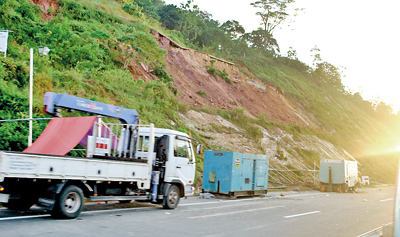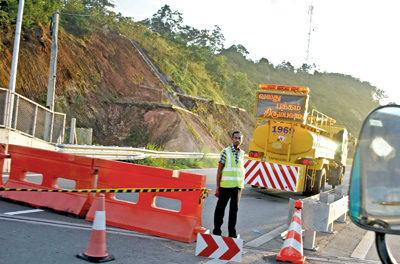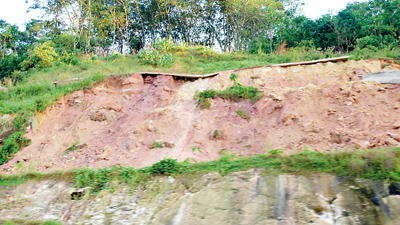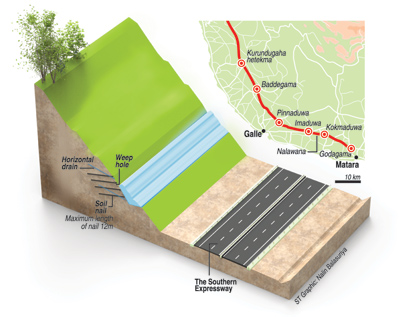News
Expressway contract default claims denied
View(s):The threat of a landslide at the 114th milepost on the southern highway between Imaduwa and Kothalmaduwa and several recent closures of the road are raising doubts about the viability of the $US741.1 million Southern Expressway project.

Repair work being carried out at the landslide site
Doubts are being cast on the engineering methods and procedures adopted in constructing roads in the mountainous terrain. Questions are also being raised over the measures taken by the contractors to preclude mudslides on slopes during heavy rains.
The construction is under investigation following claims that the massive damage on the slope, exposed last week, demonstrated that the contract had been violated.
In September, rains washed away part of the slope, creating a huge fissure.
Critics faulted the construction work carried out by the contractors and said that the particular area had not previously been landslide-prone and that the contractors had dammed a stream running through the area with concrete while building the road.
A top National Building Research Organisation (NBRO) speaking on condition of anonymity alleged that the criteria in the road development proposal had not been met by the contractors.

NBRO Chairman R.M.S. Bandara said the horizontal drains would reduce the water level in the soil. He said the new warning systems involved alarms at two places at the site and that CCTV had been installed to catch any movement of soil on the upper slopes.
The NBRO has quickly moved in and taken mitigating action by placing a horizontal draining system and an early warning system to be forewarned of any rocks falling on the expressway.
The sliding mass of mud dislodged earlier, if it had fallen, could have covered the entire width of the expressway, preventing the movement of traffic to and from Matara.
The residents in that area – up to 30,000 people – have been warned and asked to evacuate.
It is believed that the water from the stream is seeping into the soil, increasing the water pressure in the soil and loosening the soil, with the possibility of a major landslide.
RDA chairman Professor J.M.S.J. Bandara said remedial measures were continuing.
He said the slope had caved in because of the rain and the water seeping into the ground, softening the soil.
He said horizontal drainpipes had been installed and stabilization of the slope would be a gradual process. He said, because of the heavy rains, the road had been closed as a precautionary method.

The area affected by the landslide. Pix by Janath de Silva
He rejected the allegations that the contracted work had not been done to order. “All work has been done according to specifications,” he said.
Explaining the cause of the damage, he said water from the mountains in a nearby estate was flowing onto the slope and there was no provision for the water to go anywhere. “The water goes into the soil, making it unstable,” he said.
He said that although the problem was identified and fixed it was recurring. “It is cancerous,” he said.
Referring to the soil nailing technique, he said water movement was unpredictable and that different cases needed different techniques.
NBRO Chairman R.M.S. Bandara said the horizontal drains would reduce the water level in the soil. He said the new warning systems involved alarms at two places at the site and that CCTV cameras had been installed to catch any movement of soil on the upper slopes.
Additionally, vertical boreholes were being drilled to test the geological conditions underground, he said.
“We have drilled in 48 locations up to 30m deep into the ground within four days to bring the situation under control,” he said. Soil investigations would determine further work.
The NBRO chief said the RDA was responsible for monitoring the expressway project.
According to a Ministry of Disaster Management circular issued in 2011 any construction work done by the RDA has to be on the recommendation of the NBRO.
The NBRO’s Mr. Bandara said the RDA had not consulted the NBRO in the current mitigating work undertaken.

